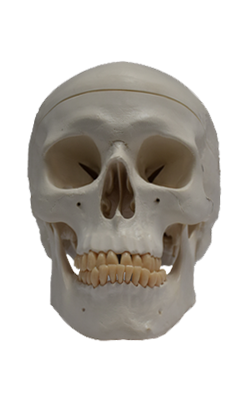Main Model

CRANIUM : Sphenoid bone

External Surface of Cranial Base
The cranial base (basicranium) is the inferior portion of the
neurocranium (fl oor of the cranial cavity) and viscerocranium
minus the mandible (Fig. 7.9). The external surface of the
cranial base features the alveolar arch of the maxillae
(the free border of the alveolar processes surrounding and
supporting the maxillary teeth); the palatine processes of the
maxillae; and the palatine, sphenoid, vomer, temporal, and
occipital bones.
The hard palate (bony palate) is formed by the palatal
processes of the maxillae anteriorly and the horizontal
plates of the palatine bones posteriorly. The free posterior
border of the hard palate projects posteriorly in the median
plane as the posterior nasal spine. Posterior to the central
incisor teeth is the incisive foramen, a depression in the
midline of the bony palate into which the incisive canals open.
The right and left nasopalatine nerves pass from the nose
through a variable number of incisive canals and foramina (they may be bilateral or merged into a single formation).
Posterolaterally are the greater and lesser palatine foramina. Superior to the posterior edge of the palate are two large
openings: the choanae (posterior nasal apertures), which are
separated from each other by the vomer (L. plowshare), a
fl at unpaired bone of trapezoidal shape that forms a major
part of the bony nasal septum (Fig. 7.9B).
Wedged between the frontal, temporal, and occipital bones
is the sphenoid, an irregular unpaired bone that consists of a
body and three pairs of processes: greater wings, lesser wings,
and pterygoid processes (Fig. 7.10). The greater and lesser
wings of the sphenoid spread laterally from the lateral aspects
of the body of the bone. The greater wings have orbital, temporal, and infratemporal surfaces apparent in facial, lateral,
and inferior views of the exterior of the cranium (Figs. 7.3.
7.4A, and 7.9A) and cerebral surfaces seen in internal views
of the cranial base (Fig. 7.11). The pterygoid processes,
consisting of lateral and medial pterygoid plates, extend
inferiorly on each side of the sphenoid from the junction of the
body and greater wings (Figs. 7.9A and 7.10A & B).
The groove for the cartilaginous part of the pharyngotympanic (auditory) tube lies medial to the spine of the
sphenoid, inferior to the junction of the greater wing of the
sphenoid and the petrous (L. rock-like) part of the temporal bone (Fig. 7.9B). Depressions in the squamous (L. fl at)
part of the temporal bone, called the mandibular fossae,
accommodate the mandibular condyles when the mouth is
closed. The cranial base is formed posteriorly by the occipital
bone, which articulates with the sphenoid anteriorly.
The four parts of the occipital bone are arranged around
the foramen magnum, the most conspicuous feature of the
cranial base. The major structures passing through this large
foramen are: the spinal cord (where it becomes continuous with the medulla oblongata of the brain); the meninges
(coverings) of the brain and spinal cord: the vertebral arteries; the anterior and posterior spinal arteries; and the spinal
accessory nerve (CN XI). On the lateral parts of the occipital
bone are two large protuberances, the occipital condyles,
by which the cranium articulates with the vertebral column.
The large opening between the occipital bone and the
petrous part of the temporal bone is the jugular foramen,
from which the internal jugular vein (IJV) and several cranial
nerves (CN IX–CN XI) emerge from the cranium (Figs. 7.9A
and 7.11; Table 7.2). The entrance to the carotid canal for
the internal carotid artery is just anterior to the jugular foramen (Fig. 7.9B). The mastoid processes provide for muscle
attachments. The stylomastoid foramen, transmitting the
facial nerve (CN VII) and stylomastoid artery, lies posterior
to the base of the styloid process.